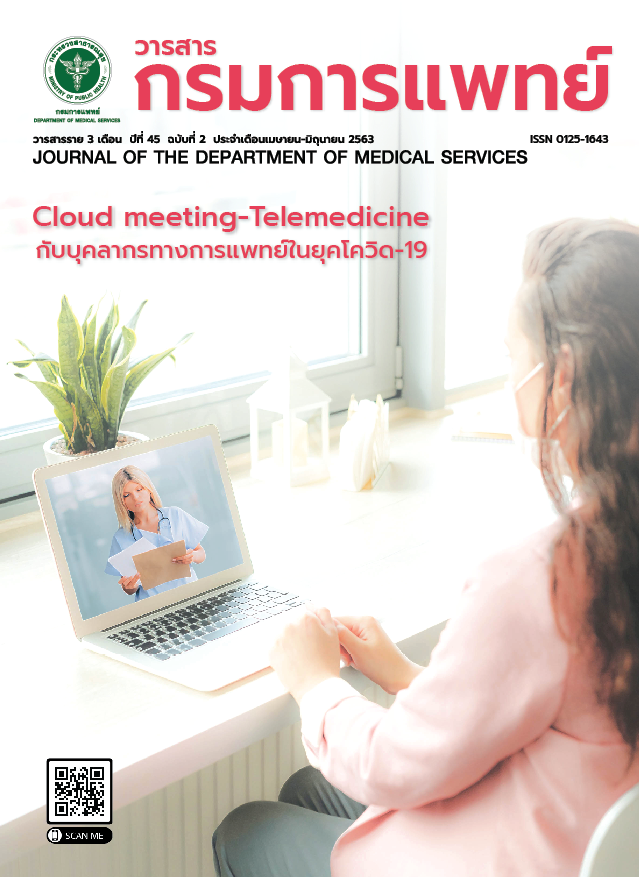The System Development of the Antimicrobial Stewardship Program for Antimicrobial Resistance Prevention at Loei Hospital
Keywords:
System development, Antimicrobial stewardship, Antimicrobial resistanceAbstract
Background: Antimicrobial resistance is an important public health problem at both the national and global levels. It is also a major problem of Loie hospital that the rate of antimicrobial resistance is likely to increase continuously.
Objective: To develop the antimicrobial stewardship program (ASP) and evaluate the use of ASP for antimicrobial resistance prevention at Loei Hospital.
Method: Research and Development design and evaluation with quasi-experimental research/ simple interrupted time series (ITS). Sample was time series data included 24-month data during January 2018 - December 2019, which divided into 14 months pre-ASP system period and 10 months post-ASP system period. The research tools consisted of antimicrobial prescription forms, monthly data record forms and the microbiological laboratory system management program (MLAB program) recorded the sensitivity and resistance of bacteria. Data were collected including the amount of drug use (defined daily doses: DDDs), the expenditure of six ATB: meropenem, levofloxacin, sulperazone, colistin, vancomycin and fosfomycin as well as antimicrobial resistance infection rates were collected. Data were analyzed using statistics including percentage, mean, Pearson’ Correlation Coefficient, Spearman correlation and segmented regression of ITS.
Results: The implement of developed-ASP system reduced the amount of use and expenditure of all antibiotics except fosfomycin. The amount of use of 3 antibiotics correlated significantly with bacterial resistance (p<0.05) that were meropenem (A.baumannii r=0.576, E.Coli r=0.425), levofloxacin (P.aeruginosa r=0.439, K.Pneumoniae r=0.426) and sulperazone (P.aeruginosa r=0.672). Importantly, analysis with segmented regression analysis after the ASP system, the decrease in the amount of use and the expenditure was indicated only 2 antibiotics: sulperazone (-0.708 DDDs/ -16,074 baht) and meropenem (-2.305 DDDs/ -87,725 baht). However, antimicrobial resistance infection rate was unchanged.
Conclusion: The ASP system was effective; however, it should integrate the variety of method to promote the appropriate use of antibiotics for preventing and reducing antimicrobial resistance infection.
References
Nordmann P, Naas T, Poirel L. Global spread of carbapenem are producing Enterobacteriaceae. Emerg Infect Dis 2011; 17: 1791-8.
World Health Organization. Antibiotic resistance. [Internet]. 2018 [cited 2019 Jun 26]. Available from: http://www.who. int/ mediacentre/factsheets/antibiotic-resistance/en/.
World Health Organization. Antimicrobial resistance: global report on surveillance 2014. [Internet]. 2018 [cited 2019 Apr 15]. Available from: apps.who.int/iris/bitstream/ 10665/112642/1/ 9789241564748_eng.pdf.
Ventola CL. The Antibiotic Resistance Crisis. Part 1: Causes and Threats. P T 2015; 40: 277– 83.
World Healt h Organization. Global Actio n Plan on Antimicrobial Resistance. [Internet]. 2018 [cited 2019 Jul 24]. Available from: http://www.wpro.who.int/entity/drug_ resistance/resources/global_action_plan_eng.pdf.
Phumart P, Phodha T, Thamlikitkul V, Riewpaiboon A, Prakongsai P, Limwattananon S. Health and Economic Impacts of Antimicrobial Resistant Infections in Thailand: A Preliminary Study. Journal of Health Systems Research 2012; 6: 352-60.
O’neill J. Tackling Drug-Resistant Infections Globally: final report and recommendations. [Internet]. 2018 [cited 2019 Jun 21]. Available from: https://amr-review.org/sites/default/ files/160518_ Final%20paper_ Accessed with%20cover.pdf/.
Health Product Vigilance Center. Thai FDA-HPVC (2014). AE Overall statistic 1984-2017. [Internet]. 2018 [cited 2019 Jun 26]. Available from: http://thaihpvc.fda.moph.go.th/thaihvc /Public/ Webpage /main.jsf.
World Health Organization. Promoting rational use of medicines: core components. WHO Policy Perspectives on Medicines; 2002.
World Health Organization. World Health Day 2011. Director general statement. Geneva: World Health Organization; 2011.
Tamma PD, Cosgrove SE. Antimicrobial stewardship. Infect Dis Clin North Am 2011; 25: 245-60.
Nathwani D, Varghese D, Stephens J, Ansari W, Martin S, Charbonneau C. Value of hospital antimicrobial stewardship programs [ASPs]: a systematic review. Antimicrobial Resistance and Infection Control 2019; 8: 13-4.
Ngamprasertchai T, Boonyasiri A, Charoenpong L, Nimitvilai S, Lorchirachoonkul N, Wattanamongkonsil L. Effectiveness and safety of polymyxin B for the treatment of infections caused by extensively drug-resistant gram-negative bacteria in Thailand. Infect Drug Resist 2018; 11: 1219-24.
National Antimicrobial Resistance Surveillance Center: NARST [Internet]. 2018 [cited 2019 Apr 1]. Available from: http:// narst.dmsc.moph.go.th/data/AMR%202000-2018-12M.pdf.
Chaiyasong C, Tiyapak P, Pinake S, Chaiyasong S. Associations between antibiotic use and resistance in Mahasarakham Hospital. IJPS 2019: 15: 98-105.
Ansari F, Gray K, Nathwani D, Phillips G, Ogston S. Ramsay C, Davey P. Outcomes of an intervention to improve hospital antibiotic prescribing: interrupted time series with segmented regression analysis. Journal of Antimicrobial Chemotherapy2003; 16: 1-7.
Downloads
Published
How to Cite
Issue
Section
License
บทความที่ได้รับการตีพิมพ์เป็นลิขสิทธิ์ของกรมการแพทย์ กระทรวงสาธารณสุข
ข้อความและข้อคิดเห็นต่างๆ เป็นของผู้เขียนบทความ ไม่ใช่ความเห็นของกองบรรณาธิการหรือของวารสารกรมการแพทย์



